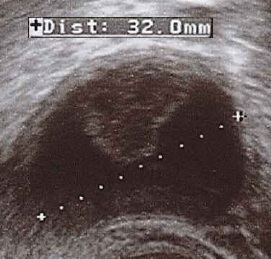Specialty gynaecology ICD-9-CM 620.1 | ICD-10 N83.1 MeSH D010048 | |
 | ||
A Corpus luteum cyst is a type of ovarian cyst which may rupture about the time of menstruation, and take up to three months to disappear entirely. A corpus luteum cyst rarely occurs at age 50+, because eggs are no longer being produced in menopausal women. Corpus luteum cysts may contain blood and other fluids. The physical shape of a corpus luteum cyst may appear as an enlargement of the ovary itself, rather than a distinct mass -like growth on the surface of the ovary.
Contents
Pathophysiology
This type of functional cyst occurs after an egg has been released from a follicle. The follicle then becomes a secretory gland that is known as the corpus luteum. The ruptured follicle begins producing large quantities of estrogen and progesterone in preparation for conception. If a pregnancy doesn't occur, the corpus luteum usually breaks down and disappears. It may, however, fill with fluid or blood, causing the corpus luteum to expand into a cyst, and stay in the ovary. Usually, this cyst is on only one side, and does not produce any symptoms.
In women of reproductive age cysts with a diameter of less than 5 cm are common, clinically inconsequential, and almost always a physiological condition rather than a cancer or other disease condition. In postmenopausal women the threshold for concern is 1 cm. Although ovarian cancer is cystic, it does not arise from benign corpus luteum cysts. Medical specialty professional organizations recommend no follow-up imaging for cysts which are clinical inconsequential.
Presentation
It can, however, grow to almost 10 cm (4 inches) in diameter and has the potential to bleed into itself or twist the ovary, causing pelvic or abdominal pain. If it fills with blood, the cyst may rupture, causing internal bleeding and sharp pain. This pain disappears within a few days of the rupture. Rarely, it may cause the ovary to twist around the ovarian ligament and can cut off the blood flow to the ovary. This is known as ovarian torsion and causes pain and other symptoms.
Interaction with medication
The fertility drug clomiphene citrate (Clomid, Serophene), used to induce ovulation, increases the risk of a corpus luteum cyst developing after ovulation. These cysts don't prevent or threaten a resulting pregnancy. Women on birth control pills usually do not form these cysts; in fact, preventing these cysts is one way birth control pills work. In contrast, the progesterone-only pill can cause increased frequency of these cysts.
